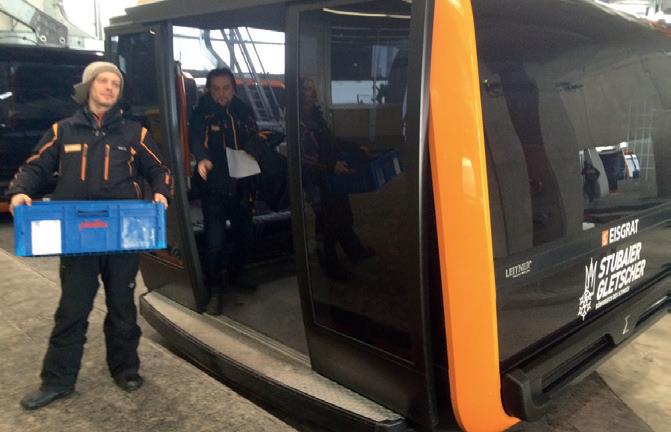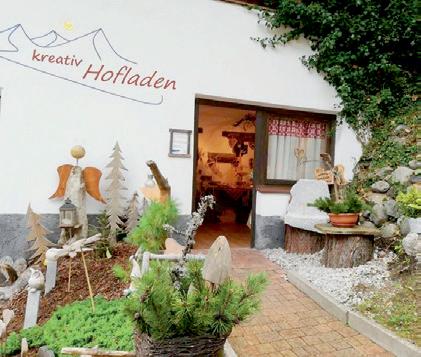
6 minute read
Top station meeting point
GAMSGARTEN AND EISGRAT IN FIGURES
Restaurants and cafés:
100 employees 2,500 seats indoors 2,500 seats outdoors 500 deckchairs 8,500 dishes daily
Processed annually:
8-10 tonnes of apples 10-12 tonnes of pasta 30-35 whole cows from the Stubai Valley
Prepared annually:
40,000 servings of goulash soup 20,000 servings of apple strudel 20.000 dumplings 10,000 Kaspress dumplings
Wonderful weather and fantastic snow – you could swish down the slopes all day. But at some point, your energy starts to flag, your tummy begins rumbling and you have the urge to satisfy one or two other needs. It’s time for a refreshment break.

Kutschenfahrten Ranalter
Eine romantische Kutschenfahrt durch die schöne Neustifter Landschaft ist ein Erlebnis, das bei keinem Stubaital-Aufenthalt fehlen darf. Die Fahrt dauert eine gute Stunde, Start ist in Stackler.
Reservierungen
bei Kutscher Friedrich Ranalter unter der Nummer +436644042431. Weitere Infos auf FB & Instagram. I n the Stubai ski areas, the large top stations with their extensive range of services are the central meeting point. On average, every winter sports enthusiast visits one of the top stations two to three times a day. To ensure that winter sports enthusiasts feel comfortable, the utmost care and full commitment is taken behind the scenes every day. On the Stubai Glacier, for example, the Gamsgarten top station at 2,620 metres above sea level and the Eisgrat top station at 2,900 metres are the central meeting points in the ski area. In addition to restaurants and toilets, there is also a sports shop, ski school office, first aid station, lockers, mobile phone charging facilities, information office and much more.
RESTAURANTS, BARS AND CAFÉS
“In the restaurants and cafés on the Gamsgarten and Eisgrat we have around 8,500 guests a day in winter,” reports Manfred Unterkirchner. He has been responsible for all the catering on the glacier for around 30 years and, together with his hundred or so employees, provides

Im Winter werden die Restaurants am Stubaier Gletscher regelmäßig mit der Seilbahn versorgt.
In winter, the restaurants on the Stubai Glacier are regularly supplied by cable car.
warm hospitality and culinary highlights. The lights go on in the kitchens and restaurants up the mountain as early as 7.30 a.m. At lunchtime, the restaurants are usually full, as the majority of winter sports enthusiasts come to eat between twelve noon and two o’clock and take around an hour to do so. Manfred knows his guests and knows what they value: “High-quality and freshly prepared regional products are important. And quick service. A challenge every day.” In between, when it is quieter, preparations are made for the next day: shaping dumplings, rolling apple strudel, cooking goulash soup (see box). “We have a wide range of products, but the classics are still the most popular,” says Manfred and immediately reveals what winter sports enthusiasts love: spaghetti, goulash soup, schnitzel, gröstl (pan-fried meat and potatoes), cheesy noodles and of course apple strudel and jam-filled dumplings. “We produce 93 per cent of the dishes ourselves, using regional products wherever possible,” Manfred reports proudly.
DELIVERY
For all of this to succeed, good planning is needed, and that starts as early as summer. “We do the provisioning before the first snow falls. In winter, we then regularly supply the restaurants using the cable cars,” Manfred explains. Special transport cars are available for the 3S lift to the Eisgrat to facilitate delivery. With the Gamsgarten cable car, on the other hand, everything has to be put into the gondola one by one. “By the time a crate is in storage, the employees have picked it up four times,” Manfred reports on the complex logistics. The Jochdohle at 3,200 metres above sea level is supplied using the snow groomer. “Deliveries have to be fast, because while they try not to break the cold chain in the valley, on the glacier they have to make sure that food that should not freeze does not freeze. Temperatures in the cold store are usually higher than outdoors,” Manfred explains.
A LOT OF TECHNOLOGY IN THE BACKGROUND
Elmar Kindl, technical manager at the Stubai Glacier, and his team ensure, among other things, that everything runs smoothly at the top stations. A complex job.
What does running a top station in the high mountains entail?
Elmar Kindl: There is a lot of technology in big buildings like the Gamsgarten or Eisgrat that our guests usually don’t even notice. This includes the entire building services with power supply, ventilation systems, heating system, water supply, waste water disposal, cooling systems as well as the information technology with IT network, music and TV system and telephone system. All equipment is located in large technical rooms in the building basements. Another focus is the maintenance of catering establishments with large kitchens, restaurants, bars and cafés. Our job is to keep all the technical equipment running to ensure the most trouble-free operation possible.
How many employees are needed for this?
Elmar Kindl: We have the Central Services Department, which is responsible for these tasks, including electricians, IT technicians, plumbers, locksmiths, painters, cleaners, etc. In the peak season, at least two employees from each trade are on duty every day to be on hand in case of any malfunctions.
What is needed for maintenance?
Elmar Kindl: Maintenance is very complex for such a big building. As we have a very long winter season and the Eisgrat is also open in summer, there is little time to carry out maintenance work. For the technical facilities, we have maintenance contracts with specialist companies that inspect everything before the season.
How much energy is needed at the glacier?
Elmar Kindl: We have a total consumption of about 14,000 MWh per year. The restaurants account for approx. 4,400 MWh of this.
How are the buildings heated?
Elmar Kindl: On the one hand by central heating, the heat comes from so-called block storage tanks, which are heated electrically at night and which heat is extracted from during the day. (Output approx. 700 kW per building). However, the room temperature is also regulated by a ventilation system with heat recovery. In this process, heat is extracted from the exhaust air and fed back into the fresh air.
HACKLS AB HOF VERKAUF Ab Hof Verkauf mit Selbstbedienung täglich von 0 bis 24 Uhr geöffnet. Wurst, Speck und Fleischwaren aus eigener Haltung und Herstellung, Freilandeier, Wachteleier, Marmeladen, Gewürzsalze, Aufstriche, Eingelegtes Gemüse und diverse Dekorationsartikel wie Zirbenkissen und personalisierte Geschenkartikel finden sie bei uns.


KREATIV HOFLADEN Unseren Kreativ Hofladen finden Sie bei den idylischen Berbauernhöfen Pfurtschell/Neustift. Der SB-Laden ist tägl. von 8:00–20:00 Uhr geöffnet. Aus dem Holz von Stadeln, Zäunen und aus dem Wald werden verschiedene Dekorations-Gegenstände und Kunstwerke geschaffen, Dabei machen wir alles selbst. Fam. Ranalter CREATIVE FARM SHOP You will find our creative farm shop at the Pfurtschell/Neustift idyllic mountain farms. The self-service shop is open daily from 8.00 a.m. to 8.00 p.m. Various decorative objects and works of art are created out of wood from barns, fences and the forest, and we make everything ourselves. The Ranalter family WERBUNG HACKLS FARM SHOP Farm shop with self-service open daily 24/7. Sausage, bacon and meat products from our own farm and production, freerange eggs, quail eggs, jams, spiced salts, spreads, pickled vegetables and various decorative items such as Swiss stone pine cushions and personalised gifts can be found here. WERBUNG
Marco Hackl, Gagersweg 20, 6165 Telfes, Tel: 0681/20137054











